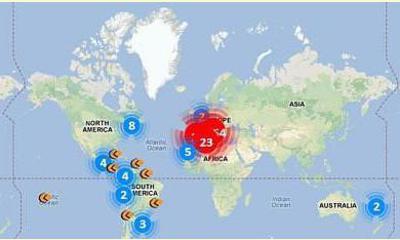|
|
Se créo el primer banco mundial del tiempo
un articulo por Pilar Rocio, Escola Cultura de Pau, Barcelona
El primer banco mundial del tiempo, llamado Cronobank fue fundado para agrupar a todos los bancos locales que permiten el intercambio de bienes, servicios y alojamiento a cambio de tiempo sin utilización de dinero.

click on photo to enlarge
Se trata de una organización sin ánimos de lucro que gestiona una alternativa de intercambio y que gana cada vez más usuarios en todo el mundo, fomentando las relaciones sociales y la igualdad.
La creación de los bancos del tiempo surgió como una forma de comprar y vender de manera muy simple que se basa en el respeto y el acceso de todos por igual, con la premisa “una hora por una hora” y que, elimina la exclusión social permitiendo a todos los usuarios cubrir necesidades mediante el intercambio por tiempo.
“Todo sin dinero, pero con más amigos en el Mundo” podría ser el lema de este banco de tiempo online www.cronobank.org que permite a la gente del Mundo entero conseguir sin dinero, y sin límites de fronteras o de idiomas: servicios, bienes, conocimientos e incluso alojamiento, usando el tiempo como moneda de cambio.
¿Cómo funciona? Muy simple, una hora de cualquier servicio y/o conocimiento se valora por igual para todos y en todo el mundo, y ese mismo tiempo genera y alienta la reciprocidad volviendo a intercambiar ese tiempo ganado, con la única restricción de que entre los usuarios del tiempo, nunca puede haber intercambio de dinero. Es decir que, los usuarios deben crearse una cuenta en el mercado del tiempo donde se publican los pedidos y ofrecimientos disponibles, y que tiene como herramientas principales, un mapa de ubicación de los demás usuarios y un buscador por palabras, y luego de cada transacción se hace una valoración sobre el comportamiento del otro intercambiante, privilegiando las relaciones por encima de los beneficios.
La unidad más pequeña de intercambio es un minuto, por lo que si cualquier participante suma tiempo otorgando bienes, servicios, conocimientos y/o alojamiento que luego le servirá para adquirir lo que otros ofrezcan a cambio de ese tiempo que tiene como ventaja que no es especulativa, por lo que los participantes, antes del intercambio, tienen la posibilidad de realizar acuerdos en los que ambas partes se sientan recompensados por su tiempo.
La comprensión de cómo valorar con tiempo es muy importante.
Un ejemplo: Laura cuida a la abuela de Marc durante dos horas y recibe dos horas en su cuenta del tiempo. Con esas dos horas le pide a Willy que haga la jardinería de su casa, por lo que Willy adquiere dos horas que utilizará para adquirir algo, y así sucesivamente…
Cada hora es única e irremplazable. Actualmente, los bancos de tiempo funcionan en muchos países y permiten cubrir necesidades fomentando la cooperación y la igualdad de sus participantes.
( Clickear aquí para la version inglês)
|








|
DISCUSSION
Pregunta(s) relacionada(s) al artículo :
How can we get to a sustainable, peaceful economy?,
* * * * *
Comentario más reciente:
Annie Leonard: How to Be More than a Mindful Consumer
The way we make and use stuff is harming the world—and ourselves. To create a system that works, we can't just use our purchasing power. We must turn it into citizen power.
by Annie Leonard
posted Aug 22, 2013
Stuff activist Annie Leonard: “Consumerism, even when it tries to embrace ‘sustainable’ products, is a set of values that teaches us to define ourselves, communicate our identity, and seek meaning through accumulation of stuff, rather than through our values and activities and our community.” YES! photo by Lane Hartwell.
Since I released "The Story of Stuff" six years ago, the most frequent snarky remark I get from people trying to take me down a notch is about my own stuff: Don't you drive a car? What about your computer and your cellphone? What about your books? (To the last one, I answer that the book was printed on paper made from trash, not trees, but that doesn't stop them from smiling smugly at having exposed me as a materialistic hypocrite. Gotcha!)
Let me say it clearly: I'm neither for nor against stuff. I like stuff if it's well-made, honestly marketed, used for a long time, and at the end of its life recycled in a way that doesn't trash the planet, poison people, or exploit workers. Our stuff should not be artifacts of indulgence and disposability, like toys that are forgotten 15 minutes after the wrapping comes off, but things that are both practical and meaningful. British philosopher William Morris said it best: "Have nothing in your house that you do not know to be useful or believe to be beautiful."
Too many T-shirts
The life cycle of a simple cotton T-shirt—worldwide, 4 billion are made, sold, and discarded each year—knits together a chain of seemingly intractable problems, from the elusive definition of sustainable agriculture to the greed and classism of fashion marketing.
The story of a T-shirt not only gives us insight into the complexity of our relationship with even the simplest stuff; it also demonstrates why consumer activism—boycotting or avoiding products that don’t meet our personal standards for sustainability and fairness—will never be enough to bring about real and lasting change. Like a vast Venn diagram covering the entire planet, the environmental and social impacts of cheap T-shirts overlap and intersect on many layers, making it impossible to fix one without addressing the others.
I confess that my T-shirt drawer is so full it's hard to close. . ... continuación.

|
|









